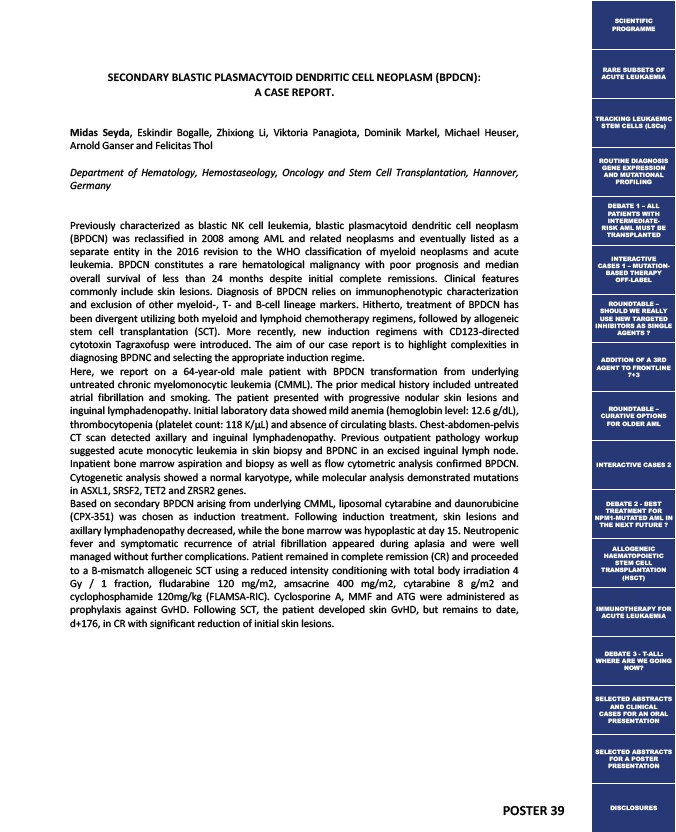
POSTER 39
SECONDARY BLASTIC PLASMACYTOID DENDRITIC CELL NEOPLASM (BPDCN):
A CASE REPORT.
Midas Seyda, Eskindir Bogalle, Zhixiong Li, Viktoria Panagiota, Dominik Markel, Michael Heuser,
Arnold Ganser and Felicitas Thol
Department of Hematology, Hemostaseology, Oncology and Stem Cell Transplantation, Hannover,
Germany
Previously characterized as blastic NK cell leukemia, blastic plasmacytoid dendritic cell neoplasm
(BPDCN) was reclassified in 2008 among AML and related neoplasms and eventually listed as a
separate entity in the 2016 revision to the WHO classification of myeloid neoplasms and acute
leukemia. BPDCN constitutes a rare hematological malignancy with poor prognosis and median
overall survival of less than 24 months despite initial complete remissions. Clinical features
commonly include skin lesions. Diagnosis of BPDCN relies on immunophenotypic characterization
and exclusion of other myeloid-, T- and B-cell lineage markers. Hitherto, treatment of BPDCN has
been divergent utilizing both myeloid and lymphoid chemotherapy regimens, followed by allogeneic
stem cell transplantation (SCT). More recently, new induction regimens with CD123-directed
cytotoxin Tagraxofusp were introduced. The aim of our case report is to highlight complexities in
diagnosing BPDNC and selecting the appropriate induction regime.
Here, we report on a 64-year-old male patient with BPDCN transformation from underlying
untreated chronic myelomonocytic leukemia (CMML). The prior medical history included untreated
atrial fibrillation and smoking. The patient presented with progressive nodular skin lesions and
inguinal lymphadenopathy. Initial laboratory data showed mild anemia (hemoglobin level: 12.6 g/dL),
thrombocytopenia (platelet count: 118 K/μL) and absence of circulating blasts. Chest-abdomen-pelvis
CT scan detected axillary and inguinal lymphadenopathy. Previous outpatient pathology workup
suggested acute monocytic leukemia in skin biopsy and BPDNC in an excised inguinal lymph node.
Inpatient bone marrow aspiration and biopsy as well as flow cytometric analysis confirmed BPDCN.
Cytogenetic analysis showed a normal karyotype, while molecular analysis demonstrated mutations
in ASXL1, SRSF2, TET2 and ZRSR2 genes.
Based on secondary BPDCN arising from underlying CMML, liposomal cytarabine and daunorubicine
(CPX-351) was chosen as induction treatment. Following induction treatment, skin lesions and
axillary lymphadenopathy decreased, while the bone marrow was hypoplastic at day 15. Neutropenic
fever and symptomatic recurrence of atrial fibrillation appeared during aplasia and were well
managed without further complications. Patient remained in complete remission (CR) and proceeded
to a B-mismatch allogeneic SCT using a reduced intensity conditioning with total body irradiation 4
Gy / 1 fraction, fludarabine 120 mg/m2, amsacrine 400 mg/m2, cytarabine 8 g/m2 and
cyclophosphamide 120mg/kg (FLAMSA-RIC). Cyclosporine A, MMF and ATG were administered as
prophylaxis against GvHD. Following SCT, the patient developed skin GvHD, but remains to date,
d+176, in CR with significant reduction of initial skin lesions.
SCIENTIFIC
PROGRAMME
RARE SUBSETS OF
ACUTE LEUKAEMIA
TRACKING LEUKAEMIC
STEM CELLS (LSCs)
ROUTINE DIAGNOSIS
GENE EXPRESSION
AND MUTATIONAL
PROFILING
DEBATE 1 – ALL
PATIENTS WITH
INTERMEDIATE-RISK
AML MUST BE
TRANSPLANTED
INTERACTIVE
CASES 1 – MUTATION-BASED
THERAPY
OFF-LABEL
ROUNDTABLE –
SHOULD WE REALLY
USE NEW TARGETED
INHIBITORS AS SINGLE
AGENTS ?
ADDITION OF A 3RD
AGENT TO FRONTLINE
7+3
ROUNDTABLE –
CURATIVE OPTIONS
FOR OLDER AML
INTERACTIVE CASES 2
DEBATE 2 - BEST
TREATMENT FOR
NPM1-MUTATED AML IN
THE NEXT FUTURE ?
ALLOGENEIC
HAEMATOPOIETIC
STEM CELL
TRANSPLANTATION
(HSCT)
IMMUNOTHERAPY FOR
ACUTE LEUKAEMIA
DEBATE 3 - T-ALL:
WHERE ARE WE GOING
NOW?
SELECTED ABSTRACTS
AND CLINICAL
CASES FOR AN ORAL
PRESENTATION
SELECTED ABSTRACTS
FOR A POSTER
PRESENTATION
DISCLOSURES